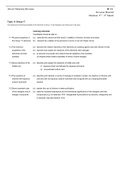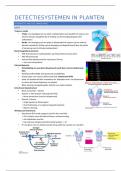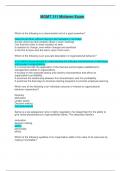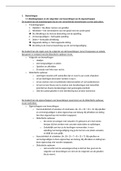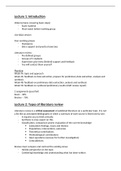Alevel Chemistry Revision IC 11
Revision Material
Duration: 2nd – 8th March
Topic 11 Group 17
The physical and chemical properties of the elements of Group 17 (the halogens) are introduced in this topic.
Learning outcomes
Candidates should be able to:
11.1 Physical properties of (a) describe the colours and the trend in volatility of chlorine, bromine and iodine
the Group 17 elements (b) interpret the volatility of the elements in terms of van der Waals’ forces
11.2 The chemical (a) describe the relative reactivity of the elements as oxidising agents (see also Section 6.3(f))
properties of the (b) describe and explain the reactions of the elements with hydrogen
elements and their (c) (i) describe and explain the relative thermal stabilities of the hydrides
hydrides (ii) interpret these relative stabilities in terms of bond energies
11.3 Some reactions of the (a) describe and explain the reactions of halide ions with:
halide ions (i) aqueous silver ions followed by aqueous ammonia
(ii) concentrated sulfuric acid
11.4 The reactions of (a) describe and interpret, in terms of changes of oxidation number, the reaction of chlorine with
chlorine with aqueous cold and with hot aqueous sodium hydroxide and recognise this as a disproportionation
sodium hydroxide reaction
11.5 Some important uses (a) explain the use of chlorine in water purification
of the halogens and of (b) state the industrial importance and environmental significance of the halogens and their
halogen compounds compounds (e.g. for bleaches, PVC, halogenated hydrocarbons as solvents, refrigerants and
in aerosols. See also Section 16.2).
, 11.1 Physical properties of the Group 17 elements
describe the colours and the trend in volatility of chlorine, bromine and iodine
interpret the volatility of the elements in terms of van der Waals’ forces
element color state m.p / b.p volatility Atomic Electronic configuration
radius
fluorine pale yellow gas increasing decreasing 0.072 1s22s22p5
chlorine green/yellow gas 0.099 1s22s22p63s23p5
bromine orange/brown liquid 0.114 1s22s22p63s23p63d104s24p5
iodine grey, black solud solid 0.133 1s22s22p63s23p63d104s24p64d105s25p5
As atomic number increases, the number of electrons increases, this increases VdW forces so stronger bonds thus m.p./b.p.
increases and volatility decreases
11.2 The chemical properties of the elements and their hydrides
X(halogen atom) + e- → X-(halide)
- All the group VII elements are oxidizing agent
- These elements have “7” outer electrons so that they tend to get one extra electron to form a noble gas structure
- The group VII elements become less reactive down the Group because the nuclear attraction are getting weaker as the
atomic sizes increase. Therefore the element becomes more difficult to get the extra electron down the group
(a) describe the relative reactivity of the elements as oxidising agents (see also Section 6.3(f))
(b) describe and explain the reactions of the elements with hydrogen
Equation for reaction Description / observation of reaction
Decreasing
H2(g) + F2(g) → 2HF(g) Reacts explosively even in cool, dark conditions
Reactivity
H2(g) + Cl2(g) → 2HCl(g) Reacts explosively in sunlight
Thermal stability
H2(g) + Br2(g) → 2HBr(g) Reacts slowly on heating
Boiling point
H2(g) + l2(g) → 2HI(g) Forms an equilibrium mixture on heating
Bond energy
Size of halogen atom increases so that the nuclear attraction decrease.
The H-X bond becomes longer and weaker.
Thus less energy needed to break the bond
The thermal stability decrease
Hydrogen bonds are present between H-F molecules, with the intermolecular forces.
The number of electron in each molecule increases so that the induced dipole / VdWs forces becomes stronger.
Boiling point the weak intermolecular forces are overcome, decreasing.
As the atomic radius of hydrogen increases down the group.
The bond length of hydrogen-halogen bonds increases
Bond energies decrease down the group.
(c) Displacement
A more reactive element displaces a less reactive element from its salts
F2 > Cl2 > Br2 > I2
weaker oxidizing agent
[more reactive]Cl2 + 2KBr → 2KCl + Br2 [less reactive]
[more reactive]Cl2 + 2KI → 2KCl + I2 [less reactive]
[orange]Br2 + 2KI → 2KBr + I2 [brown]
Colorless
Revision Material
Duration: 2nd – 8th March
Topic 11 Group 17
The physical and chemical properties of the elements of Group 17 (the halogens) are introduced in this topic.
Learning outcomes
Candidates should be able to:
11.1 Physical properties of (a) describe the colours and the trend in volatility of chlorine, bromine and iodine
the Group 17 elements (b) interpret the volatility of the elements in terms of van der Waals’ forces
11.2 The chemical (a) describe the relative reactivity of the elements as oxidising agents (see also Section 6.3(f))
properties of the (b) describe and explain the reactions of the elements with hydrogen
elements and their (c) (i) describe and explain the relative thermal stabilities of the hydrides
hydrides (ii) interpret these relative stabilities in terms of bond energies
11.3 Some reactions of the (a) describe and explain the reactions of halide ions with:
halide ions (i) aqueous silver ions followed by aqueous ammonia
(ii) concentrated sulfuric acid
11.4 The reactions of (a) describe and interpret, in terms of changes of oxidation number, the reaction of chlorine with
chlorine with aqueous cold and with hot aqueous sodium hydroxide and recognise this as a disproportionation
sodium hydroxide reaction
11.5 Some important uses (a) explain the use of chlorine in water purification
of the halogens and of (b) state the industrial importance and environmental significance of the halogens and their
halogen compounds compounds (e.g. for bleaches, PVC, halogenated hydrocarbons as solvents, refrigerants and
in aerosols. See also Section 16.2).
, 11.1 Physical properties of the Group 17 elements
describe the colours and the trend in volatility of chlorine, bromine and iodine
interpret the volatility of the elements in terms of van der Waals’ forces
element color state m.p / b.p volatility Atomic Electronic configuration
radius
fluorine pale yellow gas increasing decreasing 0.072 1s22s22p5
chlorine green/yellow gas 0.099 1s22s22p63s23p5
bromine orange/brown liquid 0.114 1s22s22p63s23p63d104s24p5
iodine grey, black solud solid 0.133 1s22s22p63s23p63d104s24p64d105s25p5
As atomic number increases, the number of electrons increases, this increases VdW forces so stronger bonds thus m.p./b.p.
increases and volatility decreases
11.2 The chemical properties of the elements and their hydrides
X(halogen atom) + e- → X-(halide)
- All the group VII elements are oxidizing agent
- These elements have “7” outer electrons so that they tend to get one extra electron to form a noble gas structure
- The group VII elements become less reactive down the Group because the nuclear attraction are getting weaker as the
atomic sizes increase. Therefore the element becomes more difficult to get the extra electron down the group
(a) describe the relative reactivity of the elements as oxidising agents (see also Section 6.3(f))
(b) describe and explain the reactions of the elements with hydrogen
Equation for reaction Description / observation of reaction
Decreasing
H2(g) + F2(g) → 2HF(g) Reacts explosively even in cool, dark conditions
Reactivity
H2(g) + Cl2(g) → 2HCl(g) Reacts explosively in sunlight
Thermal stability
H2(g) + Br2(g) → 2HBr(g) Reacts slowly on heating
Boiling point
H2(g) + l2(g) → 2HI(g) Forms an equilibrium mixture on heating
Bond energy
Size of halogen atom increases so that the nuclear attraction decrease.
The H-X bond becomes longer and weaker.
Thus less energy needed to break the bond
The thermal stability decrease
Hydrogen bonds are present between H-F molecules, with the intermolecular forces.
The number of electron in each molecule increases so that the induced dipole / VdWs forces becomes stronger.
Boiling point the weak intermolecular forces are overcome, decreasing.
As the atomic radius of hydrogen increases down the group.
The bond length of hydrogen-halogen bonds increases
Bond energies decrease down the group.
(c) Displacement
A more reactive element displaces a less reactive element from its salts
F2 > Cl2 > Br2 > I2
weaker oxidizing agent
[more reactive]Cl2 + 2KBr → 2KCl + Br2 [less reactive]
[more reactive]Cl2 + 2KI → 2KCl + I2 [less reactive]
[orange]Br2 + 2KI → 2KBr + I2 [brown]
Colorless

